|
Patrolmen
|
|
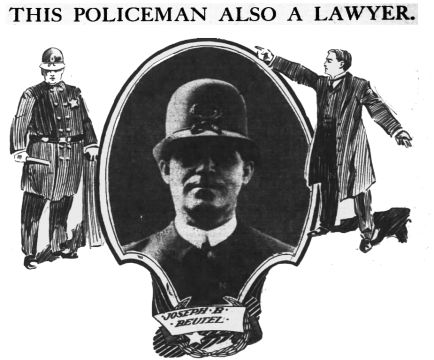
Joseph Benjamin Beutel (1872–1922)
— Testified
at grand jury in Feb, 1904; testimony not reported. A
native of Missouri, son of Frederick and
Mary Murphy Beutel, Joseph married Margaret
G. Conley in 1903. That was also the
year he passed the bar exam and on December
30 was working traffic at the corner of
Lake and Clark when the Iroquois Theater
caught fire. Three months before the
Iroquois fire the Inter Ocean newspaper ran
a large story about Joseph. He had
left his parent's Missouri farm to come to
Chicago during the 1893 Worlds Fair.
He worked as a clerk while attending night
school to learn bookkeeping, then passed the
civil service exam to become a police
officer, and went on to law school. He
decided his elementary education was lacking
so dropped out of law school to return to
high school, returning to law school and
passing the bar in 1903. He
contemplated eventually leaving the police
department and wanted to relocate in the
west, when he'd set aside a nest egg.
He wasn't counting then on having ten
children, including two sets of twins, the
last, Frank and Francis, born five years
before his death. Frank would serve in
the army during WWII. Joseph was
promoted to desk sergeant at the Chicago
avenue precinct by 1909 and left the Chicago
police department between 1917 and 1919,
dying of rectal cancer two years later.
He did make it a bit further west before he
died, to St. Paul, Minnesota where he worked
as a checker in a packing plant.
|
|
John T. or Thomas J. Brady
— According to one January,
1904 newspaper report, John testified at the
coroner's inquest about carrying an Eisendrath family member from the third
floor at Northwestern to St. Lukes hospital
where Eisendrath later died. The newspaper
reported it as having been Leonard Eisendrath from Lincoln, Illinois but the
only Eisendrath fatalities were Henrietta
and her daughter, Natalie and the only boy
from Lincoln was Leander Diffenderfer
and he was not carried into/from Northwestern .
A Jacob Leonard Eisendrath identified Ettie
Eisendrath's body but he did not die at the
Iroquois. Safe to say only that Brady was at the
fire and saw to getting a victim to St. Lukes
but even that has to be qualified: I could not find a policeman
or fireman by this name. It may have
been forty-two-year-old Canadian native,
Thomas J. Brady, a Chicago policeman.
|
|
James Clune
(1869–1945)
— Served on the force for thirty-six years.
Married to Bridget with three children. |
|
William N. Ferguson (1865–1938)
— Ferguson was sent home from the fire scene by assistant
chief Herman Schuettler (at right) for
refusing a request from a physician to help
carry a body from a balcony at the Iroquois.
Ferguson did not recognize a nearby man as a superior
officer and when Schuettler approached,
covered his badge, presumably to prevent a
citizen from reporting his conduct. To
his surprise Schuettler said, "get out"
and brought him up on charges. In a subsequent hearing before the
police trial board Ferguson denied that he
refused to help, asserting he only wanted to
remove his outer coat first, because it was
new. Sounds reasonable, right?
But he was unable to offer a reason for
having covered up his badge. The board took the case
under advisement and newspapers did not do a
follow-up report but he was still on the
force seventeen years later. He had
married Margaret Sinclair Ferguson earlier in
1903 and the pair would have two children. By
1925 he and his second wife, Lois Sayer,
relocated to his home state, Iowa, where he
worked as a gardener.
John T.
Finn (1859–1936) — Spent 38 years as a
patrolman at the Damen Avenue station,
retiring in 1922. During the first
hours after Iroquois fire he accepted the
painful task of reporting the morgue
location of bodies retrieved from the
theater. Finn was married to Mary O'Brien.
Of their five children, three sons joined the
police department.
|
|
Frank Funk (1855–1935)
— Joined the department in 1895 and retired in 1912.
At the Iroquois Theater, he helped carry
bodies. In the late 1890s he married
Franziska Pauline Bethke,
a widow with two children. Together
they had two sons, Frank jr. and Walter.
|
|
Henry T. Norris
— lost his wife and child in Iroquois fire
|
|
William Gibbons
— One of first at Iroquois fire scene, Gibbons was
implicated in case of valuables missing from a deceased theater victim.
|
|
Timothy L. Haynes
(1859–1920)
—
Patrolman Tim lived at 760 N. Ridgeway in
Chicago. He was with officer William
Gibbons (above) when two envelopes
containing Iroquois victim's jewelry
disappeared. Tim was a native of Wisconsin, married to Anna Riordan, with six or seven
children, one of whom served in the military
in WWI. He was the son of Irish
immigrants, William and Bridget Caton
Haynes. His wife, Anna, had died
eighteen months before the Iroquois fire.
In January, 1901 while with the 38th
precinct, he was injured. Was still on
the force in 1920.
|
|
John H. Keele (1854–1927)
— John was a traffic cop at Randolph and State,
within sight of the Iroquois Theater, who turned in
a fire alarm.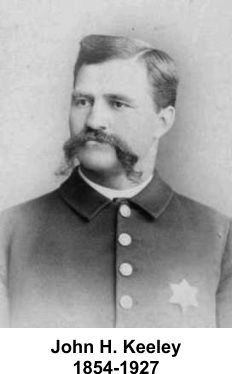 In 1903 his family lived at 615 W. 63rd St. in Chicago.
He wasmarried to Elizabeth Edge Keeley, a native
of England. John was born in Maquoketa
City, Iowa north of Davenport, Francis and
Mahala Keeley. He and Elizabeth had
one child who survived to adulthood, a
daughter named Florence. By 1920 he
and Elizabeth relocated to Lansing, Michigan
where he worked as a deputy sheriff in the
circuit court, living with their daughter's
family. John was a sharp shooter with
his revolver, hitting the bulls eye
forty-nine times out of fifty shots during a
1901 practice session preparatory to a
competition between police departments of
other cities. He was also the
conscientious sort who spoke out about
dangerous practices of street cars at the
busy Clark and Madison streets intersection.
In 1903 his family lived at 615 W. 63rd St. in Chicago.
He wasmarried to Elizabeth Edge Keeley, a native
of England. John was born in Maquoketa
City, Iowa north of Davenport, Francis and
Mahala Keeley. He and Elizabeth had
one child who survived to adulthood, a
daughter named Florence. By 1920 he
and Elizabeth relocated to Lansing, Michigan
where he worked as a deputy sheriff in the
circuit court, living with their daughter's
family. John was a sharp shooter with
his revolver, hitting the bulls eye
forty-nine times out of fifty shots during a
1901 practice session preparatory to a
competition between police departments of
other cities. He was also the
conscientious sort who spoke out about
dangerous practices of street cars at the
busy Clark and Madison streets intersection.
|
|
Andrew D. Pidgeon
(1868–1940)
— In his obituary thirty-seven years after the
Iroquois Theater fire, it was said sergeant
Pidgeon had been one of the first to arrive
at the theater and helped with rescues in
Couch Place. He may have been assigned
to the Harrison St. station at the time.
In a 1902 newspaper story he was described
as a champion pistol shooter. A
Canadian immigrant, Pidgeon was married to Delina
"Lena" Girrard and fathered two Chicago
police detectives, Walter and Marshall.
Six months after the Iroquois fire when
trying to stop a run-away horse on Lake and
Clark streets, he was dragged one hundred
feet. Earlier in 1903, after engaging
in gunfire with the suspect, he captured
purse thief, Missouri Williams. In
1908 he apprehended accused cop killer
Horace Simmons. Later that year he was
shot in the leg while arresting bookie
saloon keeper, Cyrus Lawrence.
|
|
James T. Quinlan
(1877–1943)
—Worked out of the 22nd street
station in 1903, apparently on the night
shift. At a 1934 gathering of the Iroquois
Memorial Association, by which time he was a
sergeant at police headquarters with special
responsibility for radio messaging, he said
he was sent to the Iroquois when he got to
work that day. "I took out a 3-year-old
girl with light blonde hair. I remember her
hair, which was beautiful. It was not even
singed. Her face was the color of a lobster.
I hoped to save her but the doctors
pronounced her dead. We wrapped the bodies
in blankets which the State street stories
sent over by the hundred. We laid the
bundles on the sidewalk. Later I drove an
express wagon loaded with bodies to St.
Luke's Hospital, then came back for another
load. It was grim work. All around were
husbands and fathers wanting to see if they
could find their wives and children."
Quinlan married school teacher Lillian Lynch
in 1916 and they had one child. Heart
disease forced his retirement. His
parents were James and Elizabeth Quinlan.
|
|
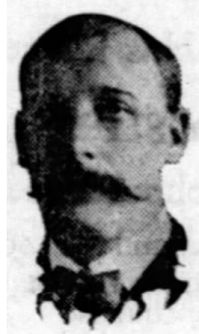
Frank Richter (1865–1921)
— According to a newspaper obituary Frank was credited with saving fifteen people and removing around forty
bodies from the Iroquois Theater.
Frank was married to Ellen Missett and the pair
had five daughters and one son. He also participated in the Eastland disaster and
was twice wounded in the line of duty. He served the department for thirty-one
years.
|
|
Albert F. Simsrott
(1864–1930)
— Patrolman
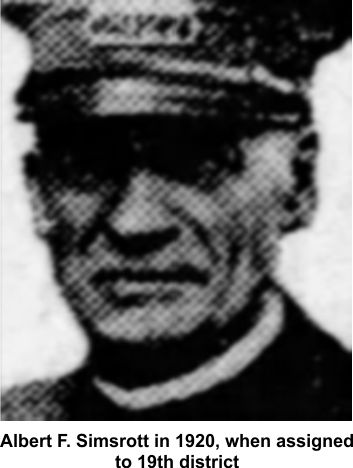 Simsrott (inaccurately spelled Sinsrott in
newspaper) testified before the coroner's
jury in January, 1904 that he carried out
six bodies found on the foyer stairways,
later identified as
Sarah Day,
Helen Dyrenforth, Marie Dicker
(newspaper error; no victim by that name),
Anna Radcliffe,
Olga Berg and
Mamie Schreiner. Prosecutors at
that early stage were anxious to learn the
identity of victims for whom a specific
cause of death could be established that
could be attributed to fault on the part of
theater personnel and that a defense
attorney could not position as
self-inflicted. Presumably Simrott's
carry-outs would not have qualified because
a defense attorney could point out that
there was no way to know the degree to which
their deaths were caused by stampeding
crowds, either through trampling or
inability to evacuate the structure.
Albert was married to Anne O'Connell and
they had three children. He was the
son of a Chicago policeman, Henry Simsrott
(1817–1886). Boat loads of arrests
between he an his father.
Simsrott (inaccurately spelled Sinsrott in
newspaper) testified before the coroner's
jury in January, 1904 that he carried out
six bodies found on the foyer stairways,
later identified as
Sarah Day,
Helen Dyrenforth, Marie Dicker
(newspaper error; no victim by that name),
Anna Radcliffe,
Olga Berg and
Mamie Schreiner. Prosecutors at
that early stage were anxious to learn the
identity of victims for whom a specific
cause of death could be established that
could be attributed to fault on the part of
theater personnel and that a defense
attorney could not position as
self-inflicted. Presumably Simrott's
carry-outs would not have qualified because
a defense attorney could point out that
there was no way to know the degree to which
their deaths were caused by stampeding
crowds, either through trampling or
inability to evacuate the structure.
Albert was married to Anne O'Connell and
they had three children. He was the
son of a Chicago policeman, Henry Simsrott
(1817–1886). Boat loads of arrests
between he an his father.
|
|
1903 Rank unknown
|
|
John Becker
— (were two Chicago cops by this name)
Testified at grand jury in February, 1904;
nature of testimony not reported.
|
|
Henry Patrick Grady (1864–1920)
— Grady of the Central station testified at
grand jury in Feb, 1904; nothing was
reported about the nature of his testimony. He was scheduled to
testify again in the criminal trial against
Will J. Davis in February, 1907 to describe
finding an unidentified female toddler in the second
floor balcony, sounded by dead victims.
She had survived by hiding her head in the
coats of deceased women on either side.
Grady carried the child downstairs and over
to Thompson's diner next to the Iroquois.
Grady lived at 478 S. Robey in Chicago with
his widowed mother, Bridget McMahon
Grady.
At her death he married
Katherine O'Brien and they had one child.
In 1906 Grady was brought up before the
police trial board for refusing to help
defend a Jewish peddler when he was attacked
by a group of medical students.
|
|
Philip A. Naughten
(1869–1946)
— Naughton testified
before the grand jury in Feb, 1904; the
nature of his testimony was
not reported. He had immigrated to
America from St. Martins in Middlesex,
England in the 1880s. Four years after
the Iroquois fire he was a detective and
married a woman named Celenia Guibord.
He was one of eight children born to Phillip
and Jeanett McDonald Naughton. His
last name was sometimes spelled as Naughton.
|
|
The following officers reportedly testified in the grand jury inquest in February, 1904
|
|
 |
|
Detectives and supervisors
|
|
Alexander Fergus Campbell
(c1853–1913) — inspector at Chicago Avenue station.
His office was used to contain family members searching for information.
There officer Finn repeated information
about victims over and over. As a college
graduate (Monmouth College) Campbell was
unusual to the department when he joined
in the late 1880s. While working
as the assistant business manager of the
Chicago Times newspaper he caught
the attention of the newspaper owner,
Chicago mayor Carter Harrison I, who
hired him as secretary of the police
department. Campbell was considered for
Chief in 1901 when the appointment instead went to
Francis O'Neill. Campbell
left the police department in 1904 to
become a special agent for the Chicago
Underwriters. Married to
Carrie Graham.
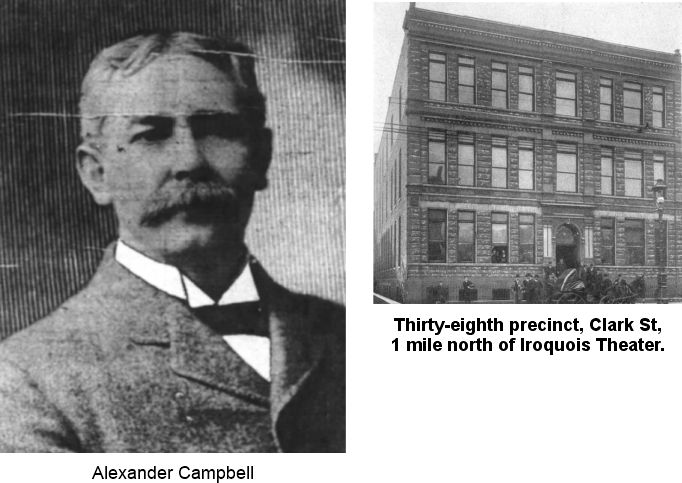
Michael Farrelly
— arrested Iroquois manager Will J. Davis
Was one of 8 officers selected to guard
president Theodore Roosevelt during his
visit to Chicago in 1905.
|
|
Edward Flaherty
— police detective who arrested Iroquois stage carpenter Cummings
|
|
Dennis Haye
— sergeant who found his son's body at Rolstons funeral home
Simon "Si" Mayer (1871–1953) —
Appointed in 1899 by Chicago mayor
Carter Harrison I. Served for
thirty years as police department
secretary and went on to become an
alderman. At the Iroquois
disaster, according to a report from a
Chicago dentist who spoke to him the
night of the fire,
David A. Hare, Si removed one
hundred bodies from the Iroquois. Son of Solomon
and Helena Mayer.
|
|
Patrick D.
McWeeney
— lieutenant who jailed bad-tempered rigger Kerr
|
|
Andrew Rohan
— lieutenant participated in arrest of coroner's defendants
|
|
Herman F.
Schuettler
(1861–1918)
— assistant police chief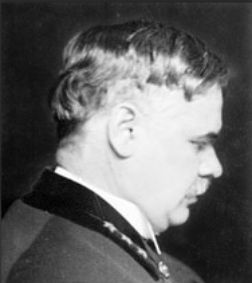
Active at Iroquois Theater scene and
subsequent theater closings. Herman
joined the department in 1883. Famously bit
off the finger of Louis Ling, maker of
Haymarket riot bombs, to prevent Ling from
shooting him. His career highlights came
when he identified critical evidence in a
much publicized homicide involving a sausage
maker named Luetgert and in 1903 when he
forced a confession from a suspect in a
series of car barn thefts. He was
Chief of the department at death.
Schuettler was a lifelong Chicago resident.
Married to Kate Flint with whom he had three
children.
|
|
John V. Sederberg
— Detective Sederberg testified at coroner's jury in
January, 1904 that he had taken an Elizabeth Bushwald from Couch Place alley where she
had fallen from the fire escape and that she
later died. Prosecutors at that early
stage were anxious to learn the identity of
victims for whom a specific cause of death
could be established that could be
attributed to fault on the part of theater
personnel and that a defense attorney could
not position as self-inflicted. Bodies in Couch Place
alley probably would not have qualified
because they had jumped, fallen or been
shoved. The newspaper paragraph
mentioning Sederberg's testimony, however,
is one of the most error-filled three inches
in thousands about the Iroquois disaster: it
referenced three non-existent victims.
I've found no evidence of a victim named
Elizabeth Bushwald. There was a
teenaged fatality named
Louise Alice Buschwahl but she had no
family relatives named Elizabeth. The only
reliable take from that story is that
Sederberg probably helped transport a woman
from Couch Place to a hospital where she
might have died.
|
|
George M. Shippy (1856-1913)
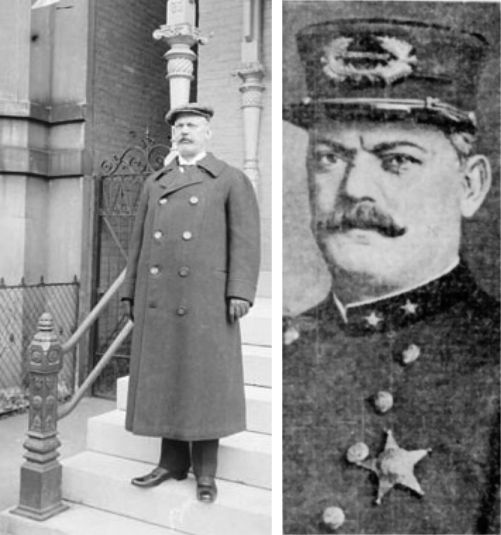
Helped clear Thompson's diner of
non-essential people so that doctors and
nurses could care for victims.
In 1907 Shippy was named Chief of Police by
Chicago mayor Fred Busse but was
forced to resign two years later for health
reasons. He spent his last days confined in
an asylum as an Alzheimer's victim
(described then as "dementia paralytica
progressiva" and "softening of the brain."
His death was caused by a paralytic stroke,
however, and he suffered from paralysis for
several years before his death. In 1908, he
was stabbed in his home by a disgruntled
activist, angry because Shippy had prevented
a labor protest. The chief, his chauffeur
and his son Harry all shot back and the
assailant was killed, but not before Harry
took a bullet in the chest. (Harry survived
the gunshot but died at age twenty-six of
complications from appendicitis surgery
seven years later.)
The son of Richard Shippy, also a police
officer, and Mary Shippy, George joined the
police department the first time around 1887
after working as a fireman and running his
own business. In keeping with Chicago
tradition then, Shippy's police career was
suspended and resumed a few times when
political parties changed. He was a staunch
Republican who refused to warm to Democrat
administrations -- so said the
anti-Republican Ocean-Pacific newspaper.
George was married to Sadie Randall Shippy
with whom he had two children.
|
|
Chief Francis O'Neill
Bio
|
"In the rush for the stairs,
they had jammed the doorway and
piled 10 deep, lying almost like
shingles. When we got up the
stairs in the dark to the front
rows of the victims, some of
them were alive and struggling,
but so pinned down by the great
weight of the dead and dying
piled upon them that three
strong men could not pull one
free. It was first necessary to
take the dead from the top of
the pile, then the rest of the
bodies were lifted easily and
regularly from their positions,
save as their arms had
intertwined and clutched.
Nothing in my experience ever
approached the awfulness of the
situation. My men wore out
simply with the carrying of the
dead bodies, to say nothing of
the awfulness of their burdens."
Francis O'Neill, 1934
|
|
|
John Tobin
— one of detectives who arrested defendants
named in coroners inquest
|
|
James H.Van Natta
— credited with saving the lives of two
children at Iroquois.
|
| |
|
